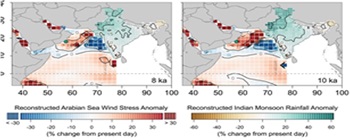The ongoing and future effects of climate change will have a major effect on human civilization. While this naturally leads to studies that focus on how ongoing climate changes can affect human health and disease, we believe it is also important to understand how climate change in the past affected human health and culture. As such, we have initiated a multidisciplinary studies to investigate the impact of climate change on human evolution. The current program is led by Balaji Rajagapolan PhD, Chairman, Department of Civil, Environmental and Architectural Engineering & CIRES, University of Colorado, Boulder and Richard J Johnson MD, Professor of Medicine, University of Colorado Anschutz Medical Campus. Other members include John Fox, PhD (Emeritus Professor of Archeology, American University of Sharjah, United Arab Emirates) and Jay Lemery MD (Professor of Emergency Medicine). The combined expertise in medicine, genetics, biology, climatology and archeology allows a multidisciplinary approach necessary to tease out how climate change affected the rise and fall of civilizations, the migration of peoples, and its influence on biology and nutrition. The current project is evaluating the demise of the indigenous Indus Valley civilization (the Harappan) and its subsequent replacement or transformation by one headed by Aryan invaders. Linguists have long studied the introduction and dominance of an Indo-European language as part of this invasion, Nonetheless, important aspects of biology, such as lactase persistence, has been excluded from the larger picture. This vital component of demographic history and eco-migration is still not fully understood, nor why and how it happened, there is some evidence that the Aryans came from the Central Asian steppes in association with a major drought (4.2 K BP event). The group is now investigating the changes in precipitation, vegetation and temperature and how it affected migrations as determined by genetics and archeology, and how the introduction of pastoralism might influence genetic traits such as lactase persistence.
Increasing evidence suggests that drought drove the Yamnayan people from the Black Sea to Europe and Central Asia. These people had domesticated the horse and introduced the chariot. Archeological evidence suggests these people may represent the Aryans and that they interacted with both the Akkadians and Harappans. Shown is a frieze found in Afghanistan near the northern border of the historic Indus Valley Civilization that dates to the period of the great drought (4.2k BP event) and shows individuals on chariots.
Jay Lemery MD |
Richard Johnson MD |
Balaji Rajagapolan PhD |
John Fox, PhD |

Around 4.2K ya there was a severe drought that lasted nearly 300 years in Mesopotamia extending south to Egypt.
There is evidence of a south migration of pastoralists from the Black Sea , bringing with them horses, chariots and cattle domesticated in Anatolia. These Indo-Aryans met up with the Akkadians, and eventually reached the Indus Valley, timing with the collapse of the Harappan Indus Valley Civilization. Shown here is a frieze of two Akkadian deities kneeling in front of cattle holding containers that might be milk. The frieze was recovered in the upper Indus River drainage and is dated at about 4 k BCE. –Provided by Dr John Fox

A reconstruction of the rainfall in India and the wind stress over Arabian Sea (the main region of monsoon jet) at 8ka and 10ka. It can be seen that northwest India was wetter during mid and early Holocene, when we posit that West Asia was drier, which triggered the migration. From Gill (2017)



